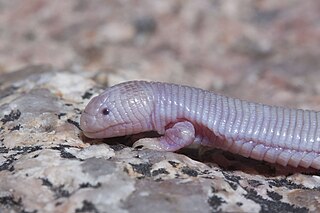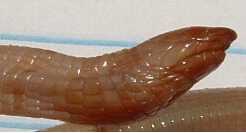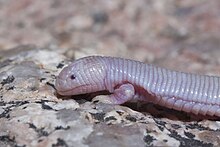
The Lepidosauria is a subclass or superorder of reptiles, containing the orders Squamata and Rhynchocephalia. Squamata includes lizards and snakes. Squamata contains over 9,000 species, making it by far the most species-rich and diverse order of non-avian reptiles in the present day. Rhynchocephalia was a formerly widespread and diverse group of reptiles in the Mesozoic Era. However, it is represented by only one living species: the tuatara, a superficially lizard-like reptile native to New Zealand.

Amphisbaenia is a group of typically legless lizards, comprising over 200 extant species. Amphisbaenians are characterized by their long bodies, the reduction or loss of the limbs, and rudimentary eyes. As many species have a pink body and scales arranged in rings, they have a superficial resemblance to earthworms. While the genus Bipes retains forelimbs, all other genera are limbless. Phylogenetic studies suggest that they are nested within Lacertoidea, closely related to the lizard family Lacertidae. Amphisbaenians are widely distributed, occurring in North America, Europe, Africa, South America, Western Asia and the Caribbean. Most species are less than 6 inches (15 cm) long.

Dibamidae or blind skinks is a family of lizards characterized by their elongated cylindrical body and an apparent lack of limbs. Female dibamids are entirely limbless and the males retain small flap-like hind limbs, which they use to grip their partner during mating. They have a rigidly fused skull, lack pterygoid teeth and external ears. Their eyes are greatly reduced, and covered with a scale.

The Amphisbaenidae are a family of amphisbaenians, a group of limbless vertebrates.

A fossorial animal is one that is adapted to digging and which lives primarily underground. Examples of fossorial vertebrates are badgers, naked mole-rats, meerkats, armadillos, wombats, and mole salamanders. Among invertebrates, many molluscs, insects, and arachnids are fossorial.
Many vertebrates are limbless, limb-reduced, or apodous, with a body plan consisting of a head and vertebral column, but no adjoining limbs such as legs or fins. Jawless fish are limbless but may have preceded the evolution of vertebrate limbs, whereas numerous reptile and amphibian lineages – and some eels and eel-like fish – independently lost their limbs. Larval amphibians, tadpoles, are also often limbless. No mammals or birds are limbless, but some feature partial limb-loss or limb reduction.

Rhineura floridana, known commonly as the Florida worm lizard, graveyard snake, or thunderworm, is a species of amphisbaenian in the family Rhineuridae. The species is the only extant member of the genus Rhineura, and is found primarily in Florida but has been recorded in Lanier County, Georgia. There are no subspecies that are recognized as being valid.

The Mexican mole lizard, also commonly known as the five-toed worm lizard, or simply as Bipes, is a species of amphisbaenian in the family Bipedidae. The species is endemic to the Baja California Peninsula. It is one of three species of amphisbaenians that have legs.

The Iberian worm lizard, Mediterranean worm lizard, or European worm lizard is a species of reptile in the family Blanidae of the clade Amphisbaenia. The Iberian worm lizard is locally known as cobra-cega (Portuguese), culebrilla ciega (Spanish), and colobreta cega (Catalan), all meaning "blind snake". Recent studies into the mitochondrial and nuclear genomic data of 47 isolated B. cinereus populations show rather large sequence divergence between two apparent clades, leading some researchers to call for a division of the Iberian worm lizard into two species. While little is known of B. cinereus in comparison with some other reptile species, new insight is growing about this primitive, ancestral reptile.

Blanus, also known as worm lizards, are a genus of amphisbaenians found in the Mediterranean region of Europe and North Africa. Like other amphisbaenians, Blanus species are specialized for a subterranean existence, with long, slender bodies, reduced limbs, and rudimentary eyes. Their skulls are powerfully constructed, allowing them to push through soil to create a burrow. Their jaws are well-developed, with large, recurved teeth and a pair of canine-like teeth in the upper jaw.

The Moroccan worm lizard is a species of amphisbaenian in the family Blanidae. The species is endemic to Morocco.

Rhineura is a genus of worm lizard endemic to North America. The genus has only one extant species but more are known from fossil record. They are also known as the North American worm lizards.

Amphisbaena alba, also known as the red worm lizard or less commonly as the white or white-bellied worm lizard, is a species of amphisbaenian in the reptilian order Squamata. Despite the large geographic range that this species covers, little is known about its ecology due to its secretive habits. A. alba has a diverse diet ranging from plant material to small vertebrates. Numerically, beetles, ants, and spiders compose the majority of their diet; however, ants, insect larvae, beetles, cockroaches, hemipterans, mole crickets, crickets, grasshoppers, termites, spiders, scorpions, pseudoscorpions, and annelids are ingested to satisfy a larger volume. The females are somewhat larger than the males, and can reach over 80 cm, which is quite large for an amphisbaenian. They are known to bury themselves in leafcutter ant nests and hide in the ants' garbage dump areas to avoid irritating the ants into attacking, and to bury themselves to avoid predation in general.

Bipedidae is a family of amphisbaenians that includes the extant genus Bipes represented by three species from Baja California and the southern coast of Mexico and the extinct genus Anniealexandria represented by one species that lived in what is now Wyoming during the earliest Eocene around 55 million years ago. Phylogenetic analysis indicates that Bipedidae is most closely related to the family Blanidae, which includes the living genus Blanus.

The Lacertoidea is a group of squamate reptiles that includes the Lacertidae, Teiidae, Gymnophthalmidae, and Amphisbaenia. The finding from molecular phylogenetic studies that the burrowing Amphisbaenia were nested in a clade with the lizard forms led Vidal & Hedges (2005) to propose a new name for the group based on shared morphogical characters, Laterata, "referring to the presence of tile-like scales that form the rings in Amphisbaenia, and are also present ventrally in Lacertiformata and Teiformata".
Maria's worm lizard is an amphisbaenian species in the family Blanidae. The species is endemic to the Iberian Peninsula.
Chthonophis is an extinct genus of amphisbaenian lizard with only one known species, Chthonophis subterraneus, from the earliest Paleocene of northeastern Montana. Chthonophis was named in 2015 on the basis of a partial lower jaw from an outcrop of the Fort Union Formation in the Bug Creek Anthills. The surfaces of the bone are well-rounded, suggesting that the remains had been partially digested by another animal before the jaw had been buried and fossilized. Chthonophis is the oldest known amphisbaenian, yet phylogenetic analysis shows that it was not the most basal. Longrich et al. (2015) classified Chthonophis in its own family, Chthonophidae, finding it to be more derived than Rhineuridae but more basal than other clades such as Blanidae and Amphisbaenidae. The existence of a derived amphisbaenian soon after the Cretaceous-Paleogene extinction event suggests that Amphisbaenia has its origins in the Cretaceous, although no Cretaceous amphisbaenians are currently known. Below is a cladogram from Longrich et al. (2015) showing the phylogenetic relationships of Chthonophis:
Anniealexandria is an extinct genus of amphisbaenian lizard known by the type species Anniealexandria gansi from the earliest Eocene of Wyoming. Anniealexandria is the only known member of the family Bipedidae in the fossil record, which otherwise only includes the extant genus Bipes from Mexico. It was named in 2009 in honor of Annie Montague Alexander, founder of the University of California Museum of Paleontology. Remains of Anniealexandria are known only from a single fossil locality in the Bighorn Basin called Castle Gardens, but within the locality its fossils are common in the Willwood Formation, usually consisting of isolated jaw bones and vertebrae. Anniealexandria seems to have been a common component of a paleofauna that included fifteen other lizard species and existed in western North America during a period of global warming in the latest Paleocene and earliest Eocene.
Mesobaena is a genus of amphisbaenians in the family Amphisbaenidae, commonly known as worm lizards. The genus is endemic to South America.











